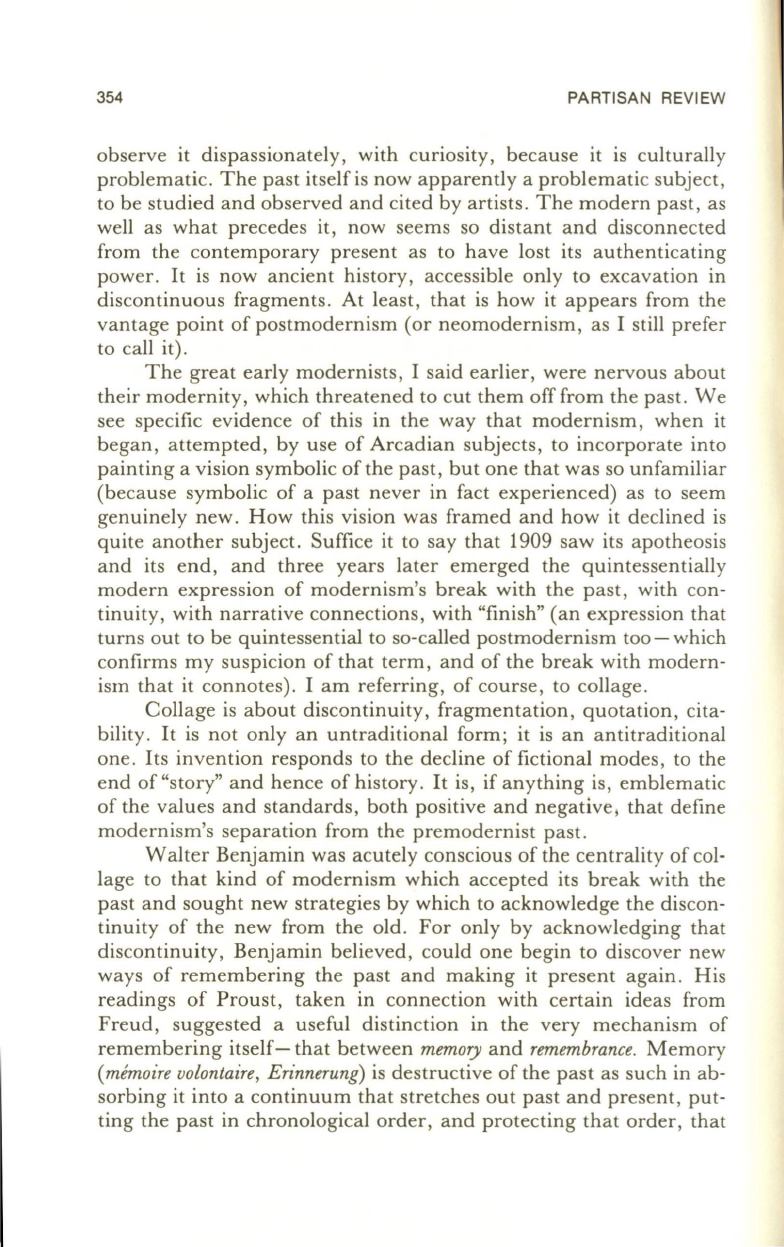
354
PARTISAN REVIEW
observe it dispassionately, with curiosity, because it is culturally
problematic. The past itself is now apparently a problematic subject ,
to be studied and observed and cited by artists. The modern past, as
well as what precedes it , now seems so distant and disconnected
from the contemporary present as to have lost its authenticating
power.
It
is now ancient history, accessible only to excavation in
discontinuous fragments . At least , that is how it appears from the
vantage point of postmodernism (or neomodernism, as I still prefer
to call it) .
The great early modernists , I said earlier, were nervous about
their modernity, which threatened to cut them offfrom the past. We
see specific evidence of this in the way that modernism, when it
began, attempted, by use of Arcadian subjects, to incorporate into
painting a vision symbolic of the past, but one that was so unfamiliar
(because symbolic of a past never in fact experienced) as to seem
genuinely new. How this vision was framed and how it declined is
quite another subject. Suffice it to say that 1909 saw its apotheosis
and its end, and three years later emerged the quintessentially
modern expression of modernism's break with the past , with con–
tinuity, with narrative connections, with "finish" (an expression that
turns out to be quintessential to so-called postmodernism too - which
confirms my suspicion of that term, and of the break with modern–
ism that it connotes) . I am referring , of course , to collage.
Collage is about discontinuity, fragmentation, quotation, cita–
bility .
It
is not only an untraditional form; it is an antitraditional
one . Its invention responds to the decline of fictional modes , to the
end of "story" and hence of history.
It
is, if anything is, emblematic
of the values and standards, both positive and negative ; that define
modernism's separation from the premodernist past.
Walter Benjamin was acutely conscious of the centrality of col–
lage to that kind of modernism which accepted its break with the
past and sought new strategies by which to acknowledge the discon–
tinuity of the new from the old . For only by acknowledging that
discontinuity, Benjamin believed , could one begin to discover new
ways of remembering the past and making it present again . His
readings of Proust, taken in connection with certain ideas from
Freud, suggested a useful distinction in the very mechanism of
remembering itself-that between
memory
and
remembrance.
Memory
(memoire volontaire, Erinnerung)
is destructive of the past as such in ab–
sorbing it into a continuum that stretches out past and present , put–
ting the past in chronological order, and protecting that order, that


